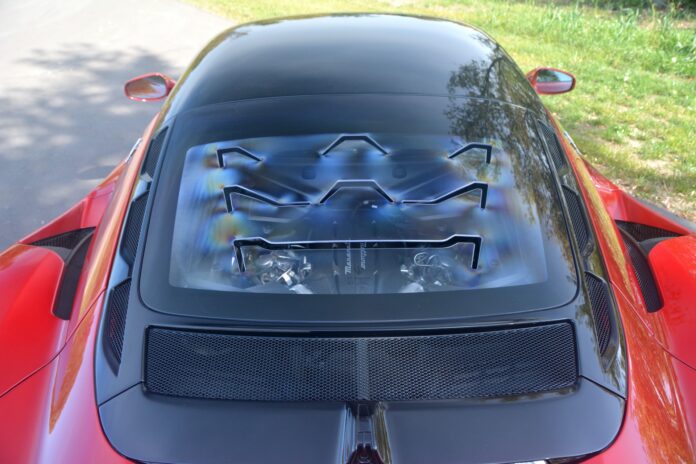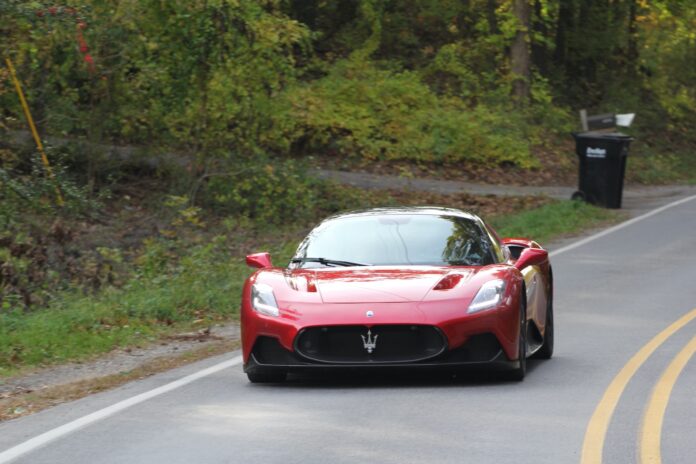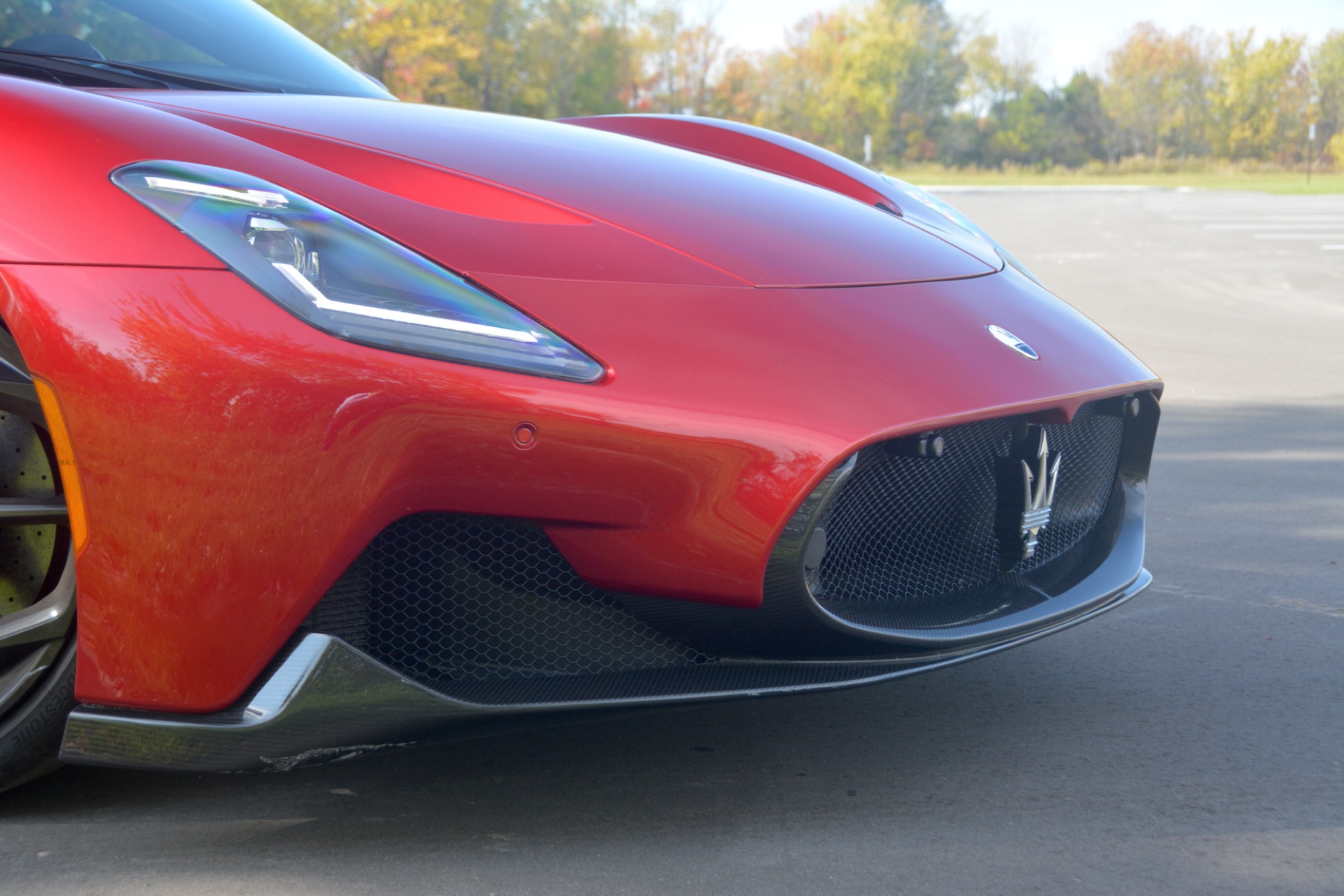We’re at a stop. A T-intersection. To the left is a short uphill run that then kinks and jogs through a series of esses before straightening out. Maserati’s twin-turbo Nettuno V6 idles quietly behind us, sounding thoroughly unimpressive, as many Italian engines do at idle. We sit, waiting for traffic to disappear over the hill. My passenger has never experienced a Maserati before, let alone something like the MC20. Her gaze shifts about the cabin, taking it in, noticing everything. She likes fast cars. She’s an F1 girl who tries not to miss a race. She’s also logged plenty of seat time in V8 BMW M3’s. She knows speed. Probably nothing like this though. Finally, my patience wears out.
“Hang on.”
That’s her cue. She leans back into the bolsters of her seat and presses “record” on her phone.
I nail the throttle and the flat red coupe launches angrily out into the intersection and begins charging up the long incline as if physics mean nothing. Forty mph. Seventy. Ninety-five. One-hundred and twenty. I let off, downshift a gear, and gently brush the brake pedal at the top, turn the wheel a hair and accelerate again through the corner. We dive into the first ess and immediately catch up with the traffic we were waiting on earlier. Brake hard then follow the slow, uninterested caravan through the esses. Ugh. This is the downside of 200 mph supercars: You find slow cars in front of you wherever you go. And no one ever wants to get out of your way.
“Where you able to get a good video?” I ask.
“Oh. I forgot all about filming when you pulled out. Sorry,” she replies, eyes wide. “WOW. This thing is AMAZING.”
That’s a word that gets uttered a lot in the few days that we have the MC20. That and lots of involuntary cursing. I expect people to invent some new swear words but everyone falls back on the obvious, automatic ones. I think they’re easier to come by when your brain is getting scrambled by the ferocious acceleration.
We grab the first cross street and do another acceleration run, pressing us back into the rich alcantara seats as I click off the shifts using the exquisitely molded carbon fiber paddles behind the steering wheel. The Nettuno now growls ferociously behind us, racing to it’s 7,000 rpm redline while the traction control struggles to keep the fat rear tires from spinning into clouds of expensive blue smoke. My reflexes are heightened and tuned into the MC20’s lightening fast moves but I have to be responsible. It takes every ounce of self control to stay under triple-digit speeds. The next road has more flow to it than the typical midwestern grid roads.
We’re able to wind through a couple of curves, down into the valleys and along some ridges, walking the fine line between exploring it’s capabilities and staying out of jail. We slip around a 70-degree corner with ease and as I throttle down the back end of the car suddenly steps out. I let off the throttle, catch the back end, and accelerate again, a little slower this time. A little. The MC20 is unflappable. So easy to drive hard, even in Race mode with no traction or stability control and that’s the sign of a well-engineered, well-balanced car. We come to another stop sign. Traffic is clear so we launch ourselves onto the freeway on-ramp. The Nettuno roars, the wheels fight for traction again, and the ’20 rockets down the on-ramp and into the freeway traffic. We head back to drop off our giggling passenger.
Maserati has built some truly great cars in the last few years but it’s the MC20 that really delivers on the promise of the Maserati name. When Americans hear the name “Maserati” they think speed, they think exotic, they think sexy Italian car. While the Trofeo-plated cars deliver on most of that, with their sweeping bodies and 590 hp turbocharged V8 engines, the MC20 really drives it home. I mean, look at it. It’s absolutely stunning. It’s the closest thing to a race car Maserati has produced in decades. Everything about it screams “functional in the pursuit of speed.” Every inlet, every vent – stylized performance. And utterly gorgeous in Rosso Vincente, a triple-coat red paint that is so deep you could trance-out looking into it. Like a crystal ball. And man, does it draw attention. Whenever I was stopped at a red light and happened to look around, I’d find everyone around me staring at it. And me. When I came out of a store, I’d inevitably find a small crowd of people circling it, cameras out, examining every facet of it’s design. Wanting to talk about it. To see inside of it. And I couldn’t blame them.
Slide your hand into the door handle opening, click the button, and the large forged carbon-fiber butterfly doors slowly rise from the sills as if surrendering. Once fully up, you can see how the carbon-fiber monocoque swoops inward toward the car’s center. This makes getting in and out relatively easy. One can simply lower their backside onto the seat and swing their legs in or one can step into the monocoque and lower themselves down into the seat. The MC20 is only the second monocoque chassis car that I’ve had the privilege to drive, the other being the Alfa Romeo 4C, but it’s much easier to get into than the 4C. The doors make it easier by putting you closer to the seat, but the sill isn’t as tall or wide as the 4C’s either.
And once you slide down into those seats, you’ll never want to leave them. While well-bolstered, they’re not so bolstered that it’s difficult to move. You sit in a mildly reclined position that’s very comfortable. The thick steering wheel is height and depth adjustable so finding the perfect driving position is easy and quick. The interior is a mixture of matte-weave carbon fiber, forged carbon fiber, black leather, black alcantara, yellow stitching, and aluminum. Very business-oriented if you seek to profit from driving quickly. A touch-screen infotainment system is mounted on the center stack and the central console is where all the dials for driving mode selection and the like are. There’s more than enough headroom under the roof for this 6’1” driver to wear a helmet. The view out the windshield is fenders and road. Nothing else. But then, nothing else is needed to help you place it in corners. The side mirrors give an excellent view back over the rear haunches and Maserati wisely installed a rear-facing camera that feeds the view to the rearview “mirror”. The digital screen takes a little getting used to but once you learn not to look deep into the “mirror” you get used to the digital video image.

The start button is on the steering wheel, Ferrari-style. Maserati’s new turbocharged 3.0L V6 doesn’t sound particularly special at idle, but like most Italian engines it comes alive as it climbs the rev range. It produces 620 hp and 538 lb-ft of torque and revs so freely under load from idle to its 7000 rpm redline that you swear it’s spinning the tires to get the tach needle to move that fast. Maserati claims a 0-60 mph time of 2.9 seconds and I fully believe that’s accurate. They also claim a top speed over 200 mph but I could never get a long enough section of freeway to test that. I’m kidding, of course, but as frenetically as the car accelerates from 90 mph on the freeway l don’t believe they’re exaggerating. The Nettuno has some big lungs and is capable of moving the light MC20 with mind-boggling speed. The engine is hooked up to Maserati’s dual-clutch 8-speed transmission that functions either as a pure automatic or as a manual using the large carbon fiber paddle shifters behind the steering wheel. It cracks off shifts as quickly as you can pull the paddles. Out back is an e-differential that limits slippage between sides of the rear axle. It seemed to do a great job of keeping the back end under control whenever we got a little crazy with it and you can feel it transferring power a bit under hard acceleration with the traction control on.
Surprisingly, it’s not an intimidating car to drive. Oh, it can be at first. Once you’ve read over the spec sheet and learned the price. More so once you’ve climbed inside, pressed the start button, and listened to the loud bark of the engine. You wonder what you’re in for. Once you’re out and about though, you quickly realize that it’s not going to try to kill you, that it actually likes you and wants to spend time with you. In default driving mode, traction and stability control keep you safe as long as you’re not too stupid. You’re able to very quickly get comfortable with the MC20 and then explore the other drive modes at your leisure: Sport, Race, and Wet.

The steering is razor sharp with a really fast ratio. Zipping through esses only takes a degree or two of steering input, which allows you to almost “think” your way through curves. It’s incredibly responsive and a pleasure to maneuver.
The suspension is completely reassuring. Consisting of double-wishbones and active dampers, it filters out all the minor road imperfections and softens the blows of the larger imperfections while delivering responsive and aggressive handling. We were able to get the back end to step out a few times but it was always catchable – hugely reassuring that you can trust it. Built into the suspension was a hydraulic lifting system to help protect the deep front splitter from getting destroyed by speed bumps and angled driveways and parking lot entrances. As someone who has learned to be very careful about how he pulls into an angled driveway to avoid damaging his splitter, you especially appreciate the feature once you see how exquisite the carbon fiber is at the front of the car.

The brakes are Brembo’s carbon-ceramic matrix units: serving tray-sized rotors and calipers as large as a shoe box. It’s probably the most respected and most capable of all braking systems in the world. They do not disappoint. While we’ve experienced them before on other cars, these seem more real-world user-friendly. First use can seem a little wooden before they bite, but once you’ve braked on a trip, they’ve got plenty of bite. When you’re really moving, they are nothing short of exceptional. Easy and intuitive to modulate, they let you know what’s happening very clearly.
There aren’t many great roads around where I live. Whenever I get a car of this caliber, I like to take it about 120 mile north where I can run a long fun road with plenty of curves and elevation changes. Maserati wouldn’t let me put that much mileage on the car (with something this expensive, I guess I can’t blame them) so I had to make do with what I had available – a mixture of freeway and mildly entertaining country roads. Over the course of the few days that we had it, we were able to get a pretty good feel for the car’s mettle. I had high hopes for the MC20’s abilities but the MC20 exceeded those hopes. This car is a part exotic sports car, part race car. It’s both refined and raw at the same time. It forces you to sharpen your reflexes to keep up with it, which makes you want to push it harder. A twenty-minute drive can utterly exhaust you mentally, physically, and emotionally. It doesn’t have to, mind you, but if you enjoy performance driving you won’t be able to resist the siren song of the engine under load, winding out to redline faster than you can count to three nor the blur of scenery rushing by.
How’s the fuel efficiency? I couldn’t tell you, honestly. And I couldn’t care less. That’s not what this car is about and if anyone dares mentions the phrase “carbon footprint” I’ll probably give him my carbon footprint right on his ass.

How was the stereo system? I’m afraid I have no idea. I think someone turned it on while I was driving once. I don’t remember it sounding awful, but who needs music when you have that sonorous Italian engine right behind your head, roaring and popping and bringing all manner of aural delight to your ears?
Would I buy one? If I won the lottery or inherited a bunch of money, in a SECOND. Although I’d personally be more drawn to the Ciello roadster. There’s just something about being exposed to the elements and being closer to the raw sound of the engine. Perhaps if Maserati can find it in their heart to forgive me for taking so long to finish this review, they’ll let us drive the Ciello some day.
The MC20 starts around $212,000 USD. Our example had about $90,000 in options added and was a better car for it. Frankly, we loved the exterior carbon fiber package ($35,000), carbon-ceramic brakes ($11,200), the suspension lifter ($4,000), the carbon fiber engine cover ($5,000) and the $10,000 Rosso Vincente paint. I don’t think I’d have changed a thing on it.
Equal parts visceral racing machine, exotic sports car, work of art, and trophy, the MC20 turned out to be an utter delight to drive. I used it as a daily driver for nearly three days and was perfectly comfortable in it. Not once did I have to complain about the driving position, entry or egress, excessive heat, switches – nothing. I didn’t have to. There was simply nothing to complain about. It’s a car that commands your vision, steals your heart, and convinces your brain that it’s a sound decision.
Frankly, it seduced me on every level.

Performance: 10
Handling: 10
Design: 11
Interior: 10
Infotainment: 10
Sound: 10
Fun: 10
Overall: 10
A special thanks to Nick Nardi for help with the rolling shots

